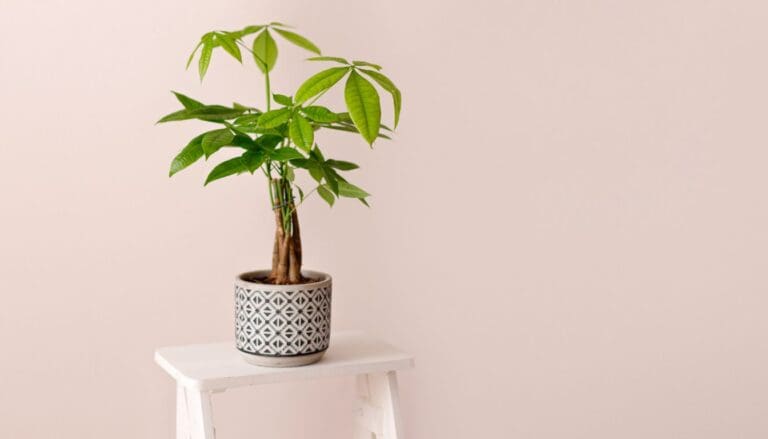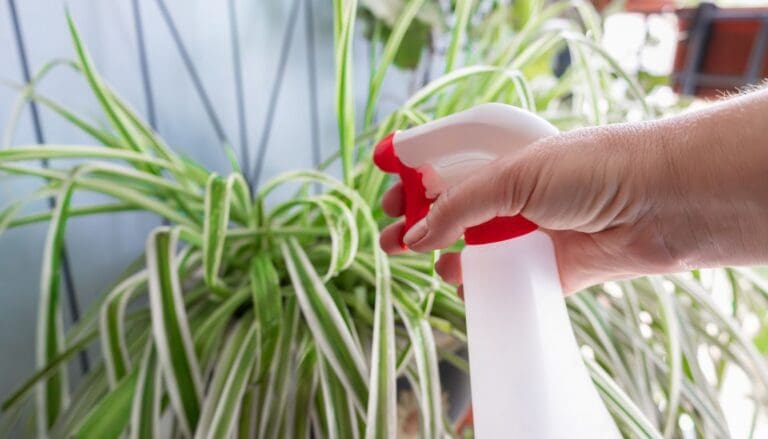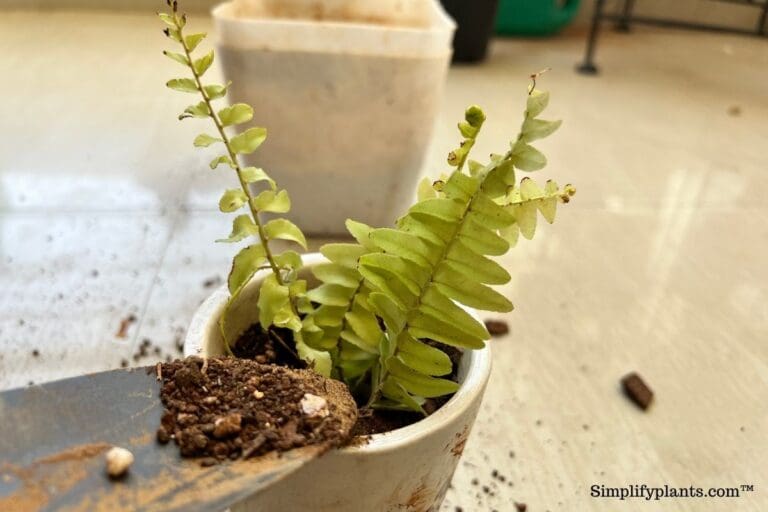Why Is My Calathea Drooping? (Causes+How To Fix)
Droopy leaves in all the houseplants are a prevalent problem. Since Calathea is known for its unique leaf patterns and their dramatic movements, no growers would enjoy seeing droopy leaves in calathea plants.
So, in this article, we shall learn why is your calathea drooping and how you can fix the same.
Dehydration is the primary cause of droopy leaves in the calathea plant. Calathea prefers moist soil, and if the soil gets bone dry between watering, the leaves start drooping. Other causes of droopy leaves in calathea are low humidity, root-bound plants, transplant shock, and pests and diseases.
Sometimes, the natural movement in Calathea is also mistaken as droopy leaves. You need to identify the reason behind droopy Calathea leaves and then start the treatment.
In this article, we will learn and understand the various reasons for drooping Calathea leaves and how you can fix them.

Please note: Simplify Plants is reader-supported. Some links in the post are affiliate links and I get a commission from purchases made through links in the post.
Why does Calathea droop?
A widespread and fundamental reason behind droopy Calathea leaves is the lack of water. Water is necessary for Calathea to maintain the turgidity of the leaves and stems so that the plant can stand straight.
Without water, you will lose the turgor pressure due to excessive moisture loss or the root’s inability to absorb enough water faster. There are other reasons too, which we will discuss further in the article.
What causes the Calathea plant to droop?
Let’s check out the reasons for drooping Calathea leaves.
Underwatering
As I mentioned earlier, a lack of water will make the Calathea plant droop. The leaf and stem cells lose their turgidity, which results in droopy leaves.
Moreover, because the plant closes up at night, being dehydrated, the plant won’t close at night. When you suspect underwatering in your Calathea, you can watch out for these signs:
- Curly, crispy leaves, turning brown at the tips and edges.
- Soil drying out.
- Try checking the soil’s dryness by using a soil meter or moisture meter.
How to revive droopy Calathea from being underwatered?
Underwatered Calathea is luckily very easy to fix. Compared to overwatering, underwatering won’t harm the plant much if action is taken within time.
- Start watering your plant immediately and soak the soil for some minutes until the excess water drains out of the potholes. Within a few hours, your Calathea will be back in good health.
- If the leaves have become too much dry and crispy, consider removing them from the plant. This will help in restoring the plant’s energy to grow new leaves.
- Make a proper watering schedule. Water whenever you find that the top 1-2 inches of soil are dry. Water your plant every week. This will keep the plant from being dehydrated again.
Also read: How Often To Water Calathea? (A Complete Calathea Watering Guide)
Overwatering

The root cause behind Calathea drooping is underwatering, but overwatering can also cause droopy Calathea. Calatheas have soft and delicate roots, which need slightly moist soil to remain healthy.
Overwatering the Calatheas and damping the roots will make them unhealthy.
If the soil remains waterlogged, the roots will get suffocated. Due to this, they will not receive any oxygen.
In such anaerobic conditions, the bacteria and fungus move towards the waterlogged Calathea, making the plant droop. They will also trigger root rot in your plants.
You can identify overwatered Calathea by watching out for some signs such as:
- Yellowing of the lower leaves
- Browning of leaves at tips and edges
- Droopy foliage despite moist soil
- Curling of leaves trying to get more water due to unhealthy roots.
- The base of the plant and the soil release a foul smell, indicating root rot.
How to revive an overwatered Calathea?
Overwatering is quite difficult to treat than underwatering. To fix an overwatered Calathea:
- Stop watering the moment you see symptoms.
- Add a layer to compost to absorb excess water.
- Locate your Calathea in a bright area. Don’t expose them to direct sun.
- Stop fertilizing for some days.
- If root rot signs are visible, treat the roots. Remove the affected leaves and black, mushy roots and repot to a new pot with fresh well-draining potting mix. You can dip the roots in a diluted hydrogen peroxide solution to disinfect them and kill existing pathogens.
Choose a pot one inch bigger than the existing one. This will also give enough space for the flexible growth of plants and roots.
Also read: How To Fix Overwatered Calathea? (Possible Cause, Signs & How To Fix)
Inadequate light

Calathea will need bright indirect light. This means Calathea should not be exposed to direct sunlight. They will need filtered light for thriving.
In their native land, Calatheas thrive under the canopies of tropical rainforests, where they get indirect light the whole day.
Besides, they will require darkness as they need to close their leaves. Excessive light all the time can hurt the plant and its natural functioning.
You should not expose them to the sun.
Exposing them to direct sunlight can:
- Fade out their leaf color and pattern.
- Resulting in droopy leaves.
- Curly leaves.
- Sunburns
- They will not close their leaves.
How to fix the light problem?
Just like Calathea doesn’t like direct sunlight, they will also not enjoy low light conditions.
To fix the light levels:
- Locate the plant where it can receive indirect light. A north or east-facing window is a good choice. It will protect your Calathea from sunburn.
- South-facing windows give too intense sunlight. If you have kept your plant near them, consider using sheer curtains, Venetian blinds, or window films to create a filter.
- In case of low light conditions, you can relocate the plant to a bright area. You can also use grow lights to give them enough light. But make sure they also receive darkness.
Also read: How Much Light Do Calathea Plants Need? (Calathea Plant Light Requirements)
Low humidity

Being tropical plants, Calathea will require high humidity to survive. These plants tend to absorb enough moisture by their broad, beautiful leaves.
If the humidity is low and the air is dry, the leaves will not get their moisture and start drooping. They will also curl and get discolored.
In low humidity, the Calathea will receive more water through transpiration. The roots won’t fill up this loss quickly, and the leaves will soon start drooping.
Identifying low humidity in Calathea is tricky because both underwatering and low humidity has more or less the same symptoms – curly leaves, crispy leaves, droopy leaves, browning.
To understand whether the problem is humidity or not, you will need a hygrometer to detect the humidity of Calathea’s location.
How to increase humidity?
- Locate the Calatheas in a location where they can receive at least 50-60% humidity levels.
- Fix a humidifier in your room to mimic the exact humidity level of Calathea’s native land. Switch it on for some hours daily between the morning and midday, or whenever the air around is dry.
- You can keep a pebble tray under the Calathea pot or group many plants to increase 10-15% of humidity.
Also read: Should I Mist My Calathea Plant? (Calathea Humidity Requirements)
Temperature stress

The favorable temperature for Calathea is between 64°F and 75°F. They are susceptible to extreme temperatures.
However, Calatheas can tolerate warm temperature as long as it remains within 80°F along with high humidity. Calathea is a tropical plant that will require high humidity for thriving.
Exposing Calatheas below 60°F will create an arid surrounding for them, which will stress the plant. Below 50°F, the plant will end up dying.
You will find browning of leaves at their tips and edges, wilted leaves, or droopy leaves. It is a sign that they are suffering from temperature stress.
Another condition where Calathea will face temperature stress is by traveling from its greenhouse to market and then from market to home.
How to fix the temperature issue?
- Try controlling the temperature for Calathea while bringing it home. After bringing it home, keep it in a place suitable for it as soon as possible.
- Place Calathea in a location where it receives its ideal temperature.
- Avoid areas like too close to heaters, radiators, or air conditioners.
- Keep the plant away from open balconies and open windows, especially if cold winds blow outside.
- Keep the plant away from the doors and windows, which are frequently closed and opened. It will prevent temperature fluctuations.
- Try inspecting the location of your Calathea by measuring it with a thermometer. This will tell you whether your Calathea can do well in its existing place or it needs change.
Also read: What Temperature Can Calathea Tolerate? (Ideal Temperature Range)
Improper fertilization

Calatheas don’t require much fertilizer compared to other houseplants. They need fertilizer every 4 weeks during the spring and summer seasons.
During the winters, they remain dormant. So, at that time, they will not need any fertilizers.
Fertilizing Calathea frequently or feeding them in their dormancy can result in droopy leaves. It can also cause brown leaves and salt burn.
Calatheas don’t need fertilizer doesn’t mean they will not need it at all. You should fertilize Calathea at least once a month during the growing seasons.
Lack of nutrition will make the Calatheas unhealthy and weak and cause yellowing and drooping of leaves.
How to fertilize Calathea correctly?
- Fertilize Calathea every month once, during the spring and summer.
- If the growing conditions are good, they will require a little more fertilizer. You can fertilize them every 2 weeks. Water the plant well to help spread the nutrients evenly in the soil and roots.
- Avoid fertilizing Calathea when they remain dormant in winters. They don’t receive the nutrients as they stop their growth. As a result, the nutrients keep accumulating on the surface.
- If you have overfertilized your Calathea, consider flushing the soil to flush off the excess salt accumulation from the potholes. Repeat this once or twice a month.
- Using distilled water or rainwater instead of tap water will also prevent salt and hard mineral build-up.
Also read: Should I Fertilize Calathea? (How Often+Best Fertilizer)
Rootbound Calathea

Calathea goes rootbound when the plant grows bigger than the pot. Rootbound Calathea means that the plant needs more space to grow.
When they get rootbound, the roots grow in a circular motion. Soon, it takes up all the space in the pot and forms a tight mass. No space remains in the soil.
Due to lack of soil, the plant will not receive enough water and nutrients, resulting in droopy Calathea. By noticing the following situations in your Calathea, you can identify whether it is rootbound:
- Some signs resemble underwatering symptoms, like droopy leaves and curry leaves.
- The plant will have stunted growth.
- The roots will be visible from the potholes and soil surface, indicating they need more space.
- To confirm your Calathea is rootbound, take out the plant and check the root growth. If the Calathea is rootbound, you will notice root growth in a circular motion.
How to resolve rootbound Calathea?
- The first important thing is repotting. Transplant it to a 1-2 inch bigger pot.
- Another way is propagation. If you want more Calatheas, you can divide the plant and plant them in several different pots. For propagating, divide the roots, making sure each cutting contains 1 part root system attached to a stem.
Also read: Do Calathea Like To Be Root Bound? (+When To Repot)
Transplant shock

Every plant will face a shock when you transplant due to a sudden change in its growing condition and environment. Sudden change can cause many problems – yellowing, drooping, wilting, etc.
You have to wait until your Calathea gets adjusted to the new environment and becomes normal. In the meantime, avoid stressing the plant further.
Moreover, while transplanting, the healthy roots can get hurt by mistake. If the damage is excess, the plant will slow down its absorption rate of water and nutrients.
When the roots fail to absorb water, they also fail to fill up the moisture loss due to transpiration. This whole situation will make the plant lose its turgidity and cause the plant to droop.
How to take care of transplant shock in Calathea?
- As transplant shock is standard, you will have to wait and take care of the plant. Give them their requirements adequately and don’t stress the plant anymore.
- Avoid fertilizing for some time.
- To prevent excess damage, carefully transplant your Calathea
With proper care, the plant will become healthy within 3-4 weeks.
Pests
The sap-sucking pests like aphids, spider mites, and mealybugs tend to suck out all the juice from the plant and the scale bugs feeding on the plant. This will make the plant weak and unhealthy, resulting in droopy leaves.
As they can spread quickly, it is better to observe your plant daily to watch out for the signs and fix them as soon as possible. Some probable signs are:
- Droopy leaves
- Leaves have web-like structures.
- White and black moving spots, indicating mealybug and spider mite infestation, respectively.
How to control pests?
- Shower your plant.
- Handpick the bugs.
- Spray neem oil to the whole plant, especially in the infested area.
- Use insecticidal soaps and soapy water to areas of infestation to remove the bugs.
- Spray herbal sprays to get rid of bugs
- In severe cases, use pesticides and miticides to kill the pests.
Also read: Do Calathes Attract Bugs? (Common Pest+Solution)
Dusty Calathea leaves

Plants tend to attract dust on their leaves. The same goes for Calathea.
When dust gets accumulated on the leaves, it increases the temperature and transpiration in Calathea. Due to this, the plant will lose moisture.
As I mentioned earlier, when the roots fail to absorb enough water, they also fail to fill up this moisture loss, so the plant droops.
How to clean the leaves?
- You can use leaf wipers to clean the leaves. They are available in all markets.
- You can also use wet clothes to clean the dust. After cleaning, make sure the plant gets good light so that the wet leaves can dry up quickly, else they’ll attract pests.
- You can use neem oil too, to clean the leaves. This will also protect your plant from pests and fungus infections.
Nyctinasty
This is a widespread behavior found in the Calatheas. They tend to move upwards and downwards constantly the whole day. Nyctinasty is a nature of Calathea where the leaves keep changing their positions as the day moves forward.
In the daytime, the leaves will open, and during the night, they will close up.
Due to such movements in the plant, sometimes their natural changing positions can look deceiving, and you might think them to be drooping down.
Before fixing the problem, observe the leaves and check the signs of damage in your plant, other than droopy leaves.
If you don’t find any such signs, then your Calathea is perfectly fine, and the leaves have changed their position recently. They are not drooping.
Also read: Why Is My Calathea Not Closing At Night? (Possible Problems+How To Fix)
Final words
There are many reasons behind drooping Calathea. Some are fixable, and some are serious. You should always observe your plants’ daily reactions to understand what is wrong with them.
Daily observation can help you identify the problems quickly, and fixing will also be straightforward and time-saving. Now that you know the different signs of the problems identifying them will be easy.
Moreover, with daily practice, you can master yourself in identifying and fixing the problems. Give your plant all its care and requirements to witness its beautiful patterns and dramatic movements daily.
Source: NCBI, University of Florida, Wikipedia, Growing Indoor Plants with Success, Agriculture, and Natural Resources, University of California, Missouri Botanical Garden.
Recommended Garden Supplies
| Product Image | Our Recommended Gardening Supplies | Check Offers! |
|---|---|---|
Top Top
Top
Top
Top
Top
Top
Top
Top | rePotme Houseplant and Tropical Classic Potting Soil Mix | Check Offer On Amazon |
 Top
Top
Top
Top
Top
Top
Top
Top | Espoma Organic Indoor Plant Food | Check Offer On Amazon |
 Top
Top
Top
Top
Top
Top
Top
Top | GooingTop LED Grow Light 6000K Full Spectrum Clip Plant Growing Lamp | Check Offer On Amazon |
 Top
Top
Top
Top
Top
Top
Top
Top | Soil Moisture Meter | Check Offer On Amazon |
 Top
Top
Top
Top
Top
Top
Top
Top | Govee Hygrometer Thermometer, Bluetooth Enabled! | Check Offer On Amazon |
 Top
Top | LEVOIT Humidifiers for Large Room(Best For Plants) | Check Offer On Amazon |
 Top
Top
Top
Top
Top
Top
Top
Top | Upgraded DIY Automatic Drip Irrigation Kit, 15 Potted Houseplants Support | Check Offer On Amazon |
 Top
Top
Top
Top
Top
Top
Top
Top | Stainless Steel Heavy Duty Gardening Tool Set | Check Offer On Amazon |
 Top
Top
Top
Top
Top
Top
Top
Top | Bonide Insecticidal Soap | Check Offer On Amazon |
 Top
Top
Top
Top
Top
Top
Top
Top | Bonide 32 oz Spray Neem Oil for Organic Gardening | Check Offer On Amazon |
 Top
Top
Top
Top
Top
Top
Top
Top | Garden Safe Fungicide | Check Offer On Amazon |






